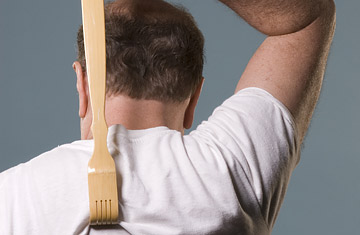
Medical science has deciphered many of the body's workings, down to the level of the gene, and isn't too far from using stem cells to repair its hobbled organs. But in many ways, the human body remains a vast and peculiar mystery.
Take the common itch. Everyone knows from experience that a good scratch can cure an itch, but doctors still don't understand the physiological mechanism behind the itch-scratch connection. And that ignorance can have serious medical consequences. The common itch isn't so benign in many conditions, including shingles and AIDS, which can cause uncomfortably severe itching. Sometimes itching can occur inexplicably, without any apparent physical cause, and a patient's unchecked scratching can lead to excessive skin damage or worse. (Read "The Year in Medicine 2008: From A to Z.")
But a study published today in the journal Nature Neuroscience offers some hope of lasting relief. A group of neuroscientists led by Glenn Giesler at the University of Minnesota, Minneapolis, hypothesized that the mechanism by which scratching relieves an itch takes place not along the nerve fibers of itchy skin but deep within the central nervous system — specifically, in the spinothalamic tract (STT) neurons in the spinal cord, which transmit information about pain, temperature and touch to the brain. (Previous studies have shown that STT neurons can be activated with the application of an itch-producing chemical like histamine and that the neurons send that itch sensation to the brain.)
In the Minnesota study, researchers sedated macaque monkeys and placed recording electrodes in their spinal nerves. They injected histamine into the monkeys' lower legs to produce an itch, and the STT neurons fired up. The researchers then scratched the paralyzed, itchy legs with a metal device that mimics the sensation of monkey fingers and found that the firing rate in the neurons dropped rapidly. That sudden drop-off in firing is the neurological equivalent of the relief felt after a good scratch, indicating that scratching seemed to calm the nerves and therefore relieve the itch. The findings supported the researchers' initial hunch that the itch sensation was not located along the skin of the monkeys' legs where histamine had been injected and that relief did not occur where the metal claw was scratching. Rather, both sensations were rooted in the spinal cord. (See pictures of an X-ray studio.)
When the team scratched the leg without first creating an artificial itch, the STT neurons fired — the normal STT-neuron response — but scratching did nothing to calm them. That demonstrates that STT nerves react differently to the sensation of a scratch when it happens in response to an existing itch. The researchers then injected a pain-producing chemical into the monkeys' legs, which also spurred the firing of STT neurons. Again scratching did nothing to calm them, suggesting that the nerve-dampening effect of scratching applies uniquely to itching, not pain.
Giesler theorizes that the itch sensation creates an excited state in the STT neurons that scratching inhibits — as if our fingernails were sending a message to spinal-cord neurons to cool off. Scientists are still a long way from understanding the itch-scratch phenomenon, and while Giesler's study gives them a good place to start, neuroscientists caution that in humans, the mysteries of itching and scratching may go beyond the physiological: emotional and psychological factors are also often at play, especially in cases of unexplained, unremitting itching or itching of phantom limbs.
The hope is that doctors will one day be able to prescribe drugs or other treatments to alleviate persistent itch. "This would produce the relief from itching caused by scratching but without the damage caused by sustained scratching," says Giesler. And that — for those who have had an itch they can't quite reach — would be a minor medical miracle.
